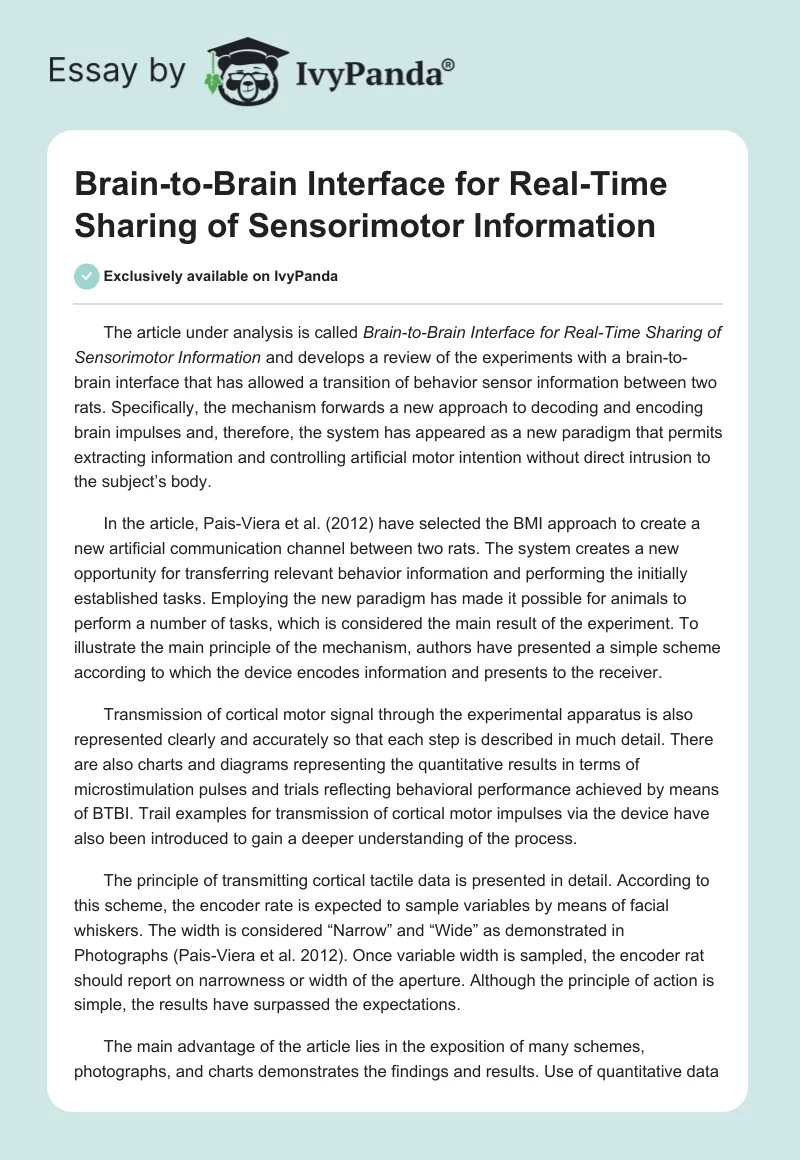The article under analysis is called Brain-to-Brain Interface for Real-Time Sharing of Sensorimotor Information and develops a review of the experiments with a brain-to-brain interface that has allowed a transition of behavior sensor information between two rats. Specifically, the mechanism forwards a new approach to decoding and encoding brain impulses and, therefore, the system has appeared as a new paradigm that permits extracting information and controlling artificial motor intention without direct intrusion to the subject’s body.
In the article, Pais-Viera et al. (2012) have selected the BMI approach to create a new artificial communication channel between two rats. The system creates a new opportunity for transferring relevant behavior information and performing the initially established tasks. Employing the new paradigm has made it possible for animals to perform a number of tasks, which is considered the main result of the experiment. To illustrate the main principle of the mechanism, authors have presented a simple scheme according to which the device encodes information and presents to the receiver.
Transmission of cortical motor signal through the experimental apparatus is also represented clearly and accurately so that each step is described in much detail. There are also charts and diagrams representing the quantitative results in terms of microstimulation pulses and trials reflecting behavioral performance achieved by means of BTBI. Trail examples for transmission of cortical motor impulses via the device have also been introduced to gain a deeper understanding of the process.
The principle of transmitting cortical tactile data is presented in detail. According to this scheme, the encoder rate is expected to sample variables by means of facial whiskers. The width is considered “Narrow” and “Wide” as demonstrated in Photographs (Pais-Viera et al. 2012). Once variable width is sampled, the encoder rat should report on narrowness or width of the aperture. Although the principle of action is simple, the results have surpassed the expectations.
The main advantage of the article lies in the exposition of many schemes, photographs, and charts demonstrates the findings and results. Use of quantitative data is important because it serves as strong evidence to qualitative information. Additionally, the authors employ sufficient terminology and succinctly define their meaning. What is more importantly is that these definitions are delivered in mutual relation with each other. Such an approach is helpful in comprehending the main points of the article. Another advantage consists in accurate representation of the experiment that does not have analogue in related literature.
Despite the existing advantage, there are certain weaknesses. Specifically, the authors fail to describe methodology of the experiment; instead, they have paid closer attention to description of the experiment and the results. The discussion section is two broad, which prevent the audience from understanding the main points of the trial.
In conclusion, the article is of great value for biologists who strive to combine scientific inventories to explore the new behavioral paradigms. The main advantage of the article is the availability of photos, schemes, diagrams, and charts supporting qualitative data. In addition, the authors have also provided sufficient explanation for the terms presented in the research. As per disadvantage, the emphasis should be placed on the broad discussion that fails to highlight the leading directions of the experiment. In general, the article has implications for further research in the sphere of biology and scientific discoveries that relate to behavioral patterns and paradigms.
Reference
Pais-Viera, M., Lebedev, M., Kunicki, C., Wang, J., and Nicolelis, M. A. (2012). A Brain-to-Brain Interface for Real-Time Sharing of Sensorimotor Information. Scientific Reports. 3 (1319), 1-10.


